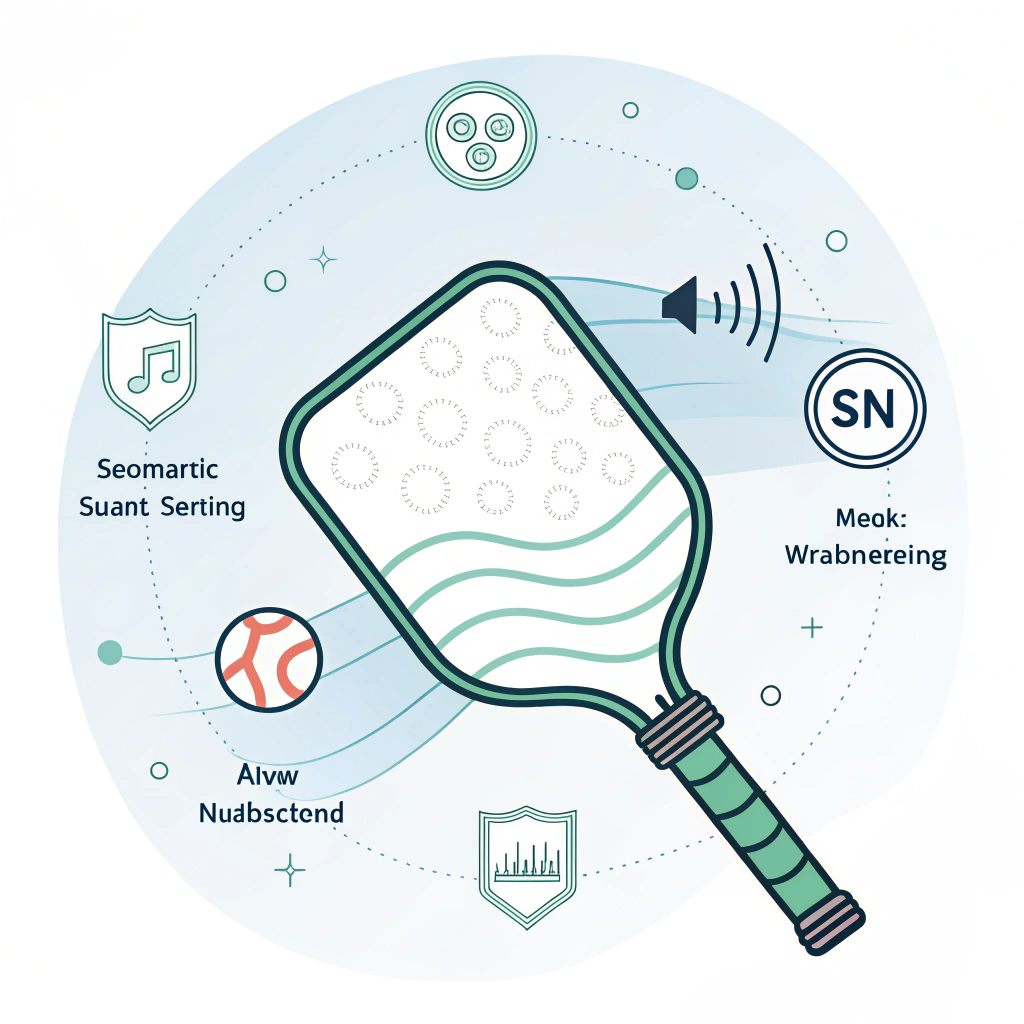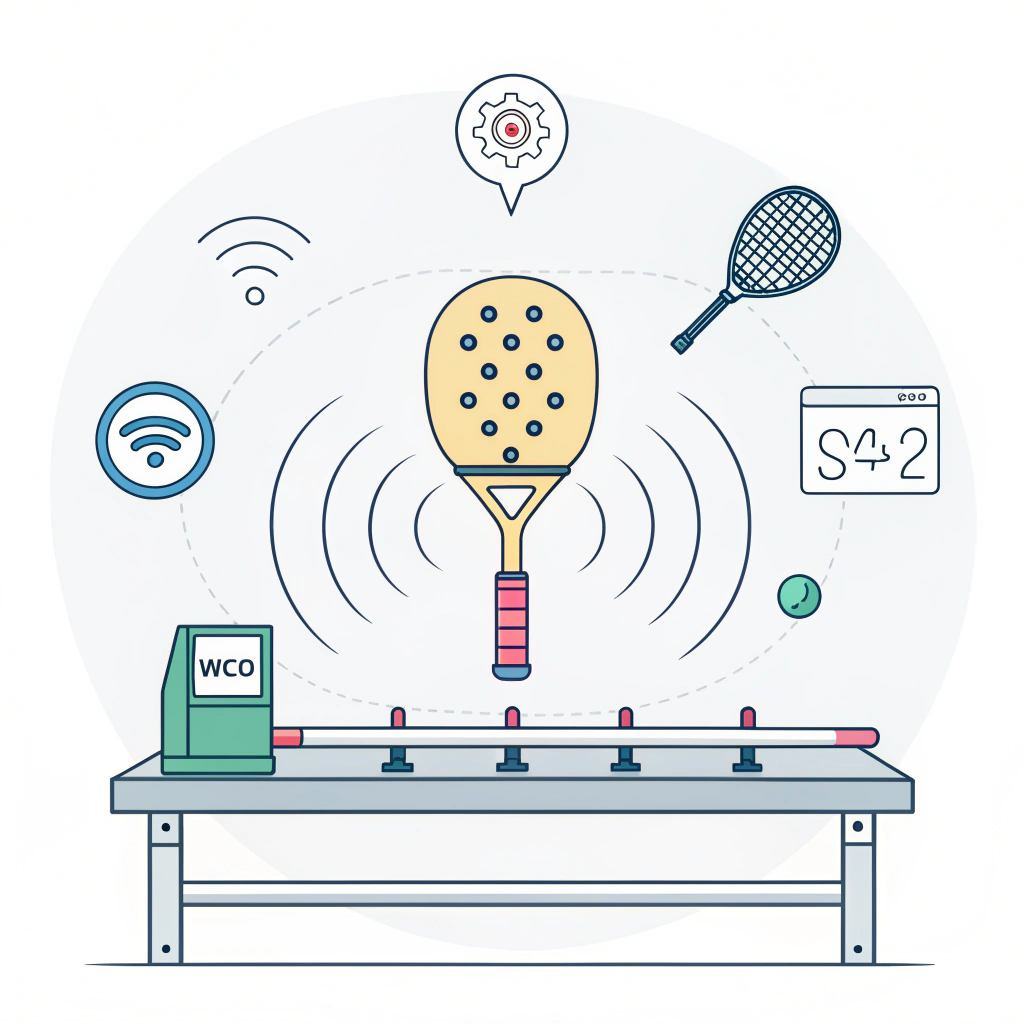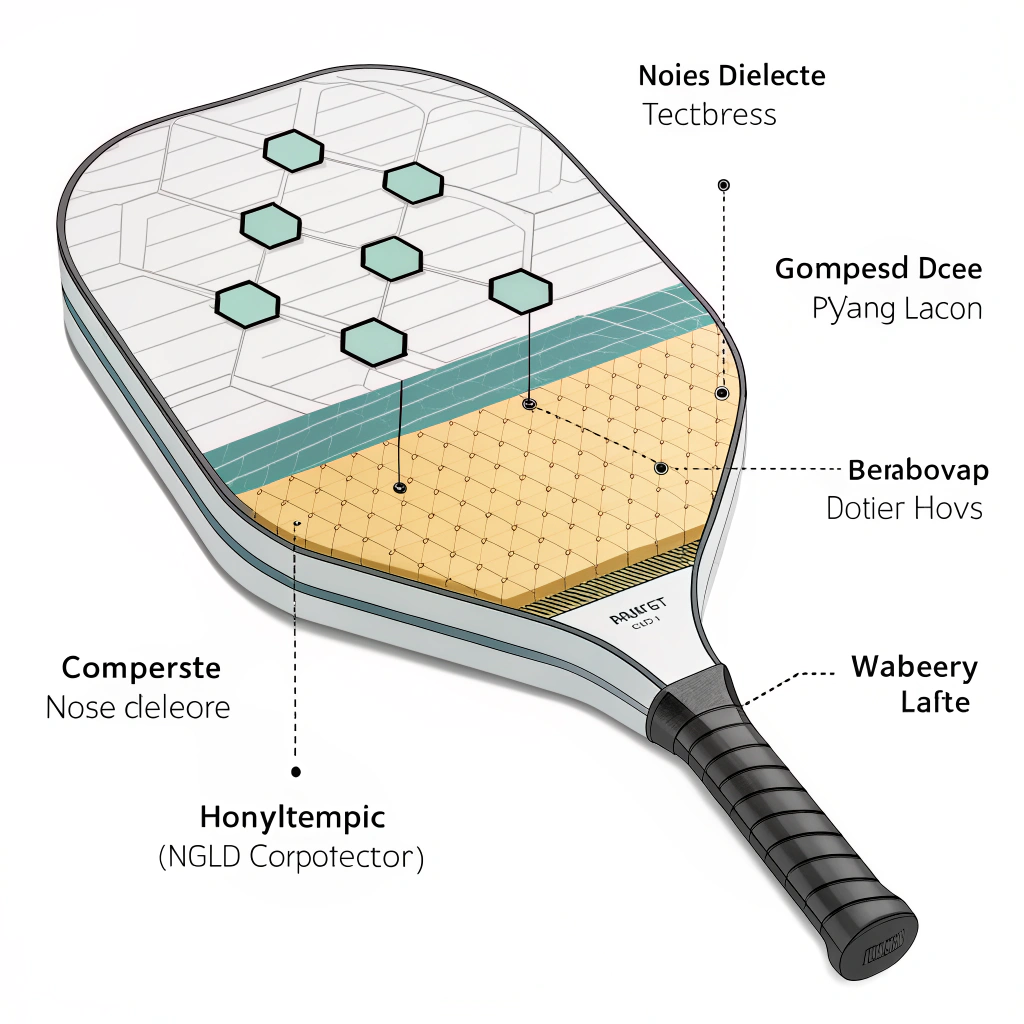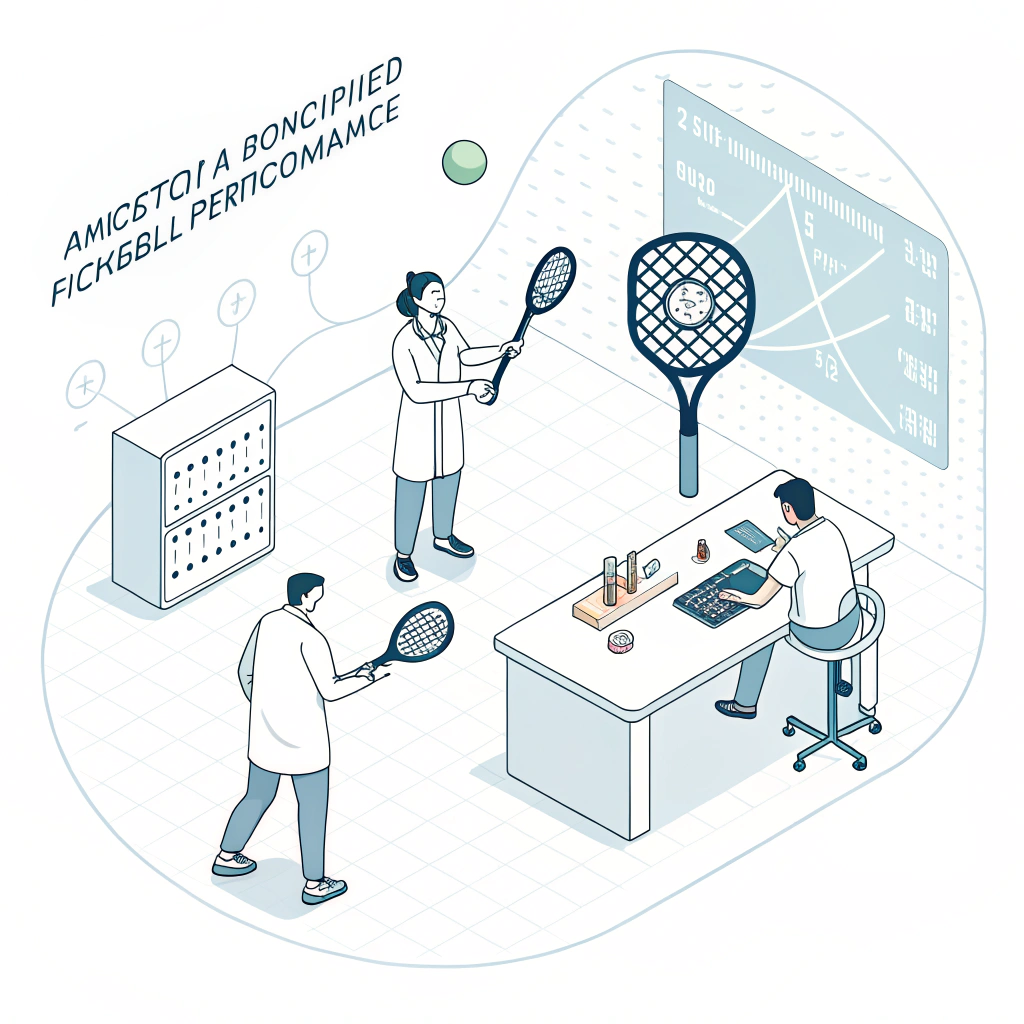Acoustic testing and noise reduction techniques are essential to ensure high performance and minimal vibration in pickleball paddle manufacturing. They not only improve the overall playing experience by reducing distracting sound and ensuring better control, but also serve as critical quality control measures for maintaining structural integrity throughout production.
In the competitive world of sports equipment, particularly in pickleball paddle production, creating a product that offers both durability and impeccable performance is crucial. Acoustic testing1 provides a way to measure vibration, noise, and sound transmission in paddles, ensuring that each unit meets strict performance standards. These tests help identify inconsistencies in material behavior that could affect a paddle’s feel, impact absorption, and overall responsiveness.
Acoustic testing in manufacturing evaluates how a paddle reacts under impact as well as its sound dampening properties. In simple terms, the process allows engineers and R&D teams to determine:
- How vibrations are transmitted through the paddle structure.
- How material selection and construction techniques influence performance.
- What modifications are needed to achieve optimal balance between power, control, and user comfort.
The manufacturing of pickleball paddles usually involves three key processes: hot pressing2, cold pressing, and thermoforming3. Each method has unique implications for acoustic properties and noise generation.
Hot pressing involves heating the composite materials and applying high pressure to form the paddle. It is popular due to its high production efficiency and ability to produce durable paddles. However, the thermal and pressure application can sometimes alter the intrinsic properties of carbon fiber and composite materials4, which may result in changes in acoustic behavior. The rapid curing process may also lead to micro-level inconsistencies that can affect the paddle’s vibration control and sound dampening capacity.
Cold pressing uses mechanical pressure at room temperature to shape the paddle. This method excels in maintaining the materials’ original properties, such as flexibility in fiberglass paddles and the precise layer lamination when combining carbon fiber with other composites. The benefit of cold pressing is that it typically preserves the intended acoustic characteristics, ensuring that the paddle’s vibration damping is both effective and predictable. However, the extended processing time and the challenge of maintaining uniform pressure can sometimes lead to minor variations in acoustic quality.
Thermoforming heats the materials until they soften and then molds them into the desired shape. This method is ideal for producing paddles with complex constructions and varying thickness profiles. While thermoforming allows engineers to design paddles with integrated noise reduction features, it requires a careful balance. The process needs to ensure that the heat does not negatively impact the core materials (such as Nomex Honeycomb Core5 or Polymer Honeycomb Core) that play a significant role in managing vibrations. The complexity of thermoforming can, if not controlled properly, lead to inconsistencies in acoustic performance.
The table below summarizes the key production methods and their effects on acoustic qualities:
| Production Process | Advantages for Acoustic Performance | Challenges in Noise Reduction |
|---|---|---|
| Hot Pressing | High production efficiency; strong bonding ensuring structural integrity. | Potential material alteration affecting sound dampening. |
| Cold Pressing | Preserves material properties; precise control over paddle structure. | Longer production cycles; uniform pressure maintenance. |
| Thermoforming | Allows complex designs; precise material distribution ideal for custom damping. | Requires careful temperature control; may affect core damping. |
Reducing noise and controlling vibration are paramount for enhancing the performance and durability of pickleball paddles. Modern production techniques incorporate several noise reduction methods, which not only improve the playing experience but also add value during quality control inspection. The following techniques are particularly effective:
-
Material Selection and Composite Design
By carefully choosing carbon fiber types (such as 3K, 12K, or T300) and combining them with fiberglass or other composite materials, manufacturers can optimize the paddle’s ability to dampen noise. For example, a combination of carbon fiber and fiberglass can yield a paddle that balances hardness with flexibility, thereby reducing excess vibration. -
Incorporation of Damping Layers
Integrating damping layers between the outer surface and the core can absorb vibrations effectively. These layers work as buffers, reducing the transmission of sound waves throughout the paddle structure. -
Advanced Core Materials
Core materials like Nomex Honeycomb Core, Aluminum Honeycomb Core, and Polymer Honeycomb Core are engineered to absorb shock and minimize vibration. Their unique structural properties help dampen impact noises while maintaining the paddle’s responsiveness and control. -
Precision Controlled Production Methods
Processes such as cold pressing allow for a more consistent material distribution, preserving the original acoustic qualities of the materials. When integrated with acoustic testing protocols, these methods ensure that each paddle meets the required noise reduction standard without compromising the product’s durability. -
Post-Production Acoustic Testing and Calibration
Regular post-production acoustic evaluations help in confirming that the manufacturing adjustments are effective. Testing equipment can measure decibel levels produced during impact and assess if any undesired frequencies are present. This data is then used to make on-the-fly adjustments in the production settings.
For companies invested in pickleball paddle manufacturing, robust acoustic testing protocols serve as the backbone of quality assurance. These protocols integrate both in-line and final inspection phases:
In the in-line phase, acoustic sensors and vibration analysis systems are integrated directly into the production line. This real-time monitoring helps detect anomalies as the paddle is molded or pressed. Key steps include:
- Calibration of Sensors: Regular calibration ensures that the sensors accurately capture vibration levels during production.
- Real-Time Data Capture: Acoustic measurement systems capture data on vibration intensities that are compared against predefined standards.
- Immediate Feedback Loop: Any discrepancies are immediately flagged to operators, who can adjust production parameters like pressure, temperature, or material feed.
Once the paddle is assembled, a comprehensive acoustic analysis is conducted in a controlled environment:
- Standardized Impact Testing: Each paddle is subject to a standardized impact test to measure sound output and vibration response.
- Frequency Analysis: The tests help dissect the frequency spectrum of the paddle's response, identifying specific noise peaks that can be optimized.
- Comparative Analysis: Data from the test is compared against historical benchmarks to ensure consistent quality and identify areas for improvement.
A flowchart summarizing the acoustic testing process can be useful:
- Sensor Calibration → 2. Real-Time In-Line Testing → 3. Data Analysis → 4. Adjust Production Parameters → 5. Post-Production Evaluation → 6. Final Quality Review
A leading manufacturer of pickleball paddles recently integrated sophisticated acoustic testing protocols within its production line. Their objective was to minimize the noise generated during impact, leading to both a quieter paddle and improved overall playability.
The company had experienced feedback from competitive players noting that excessive vibrations during play could impair both performance and comfort. The task was to identify the root causes of these vibrations and implement a series of systematic improvements.
The project team decided to focus on:
- Material Composition: They refined the carbon fiber composite configuration, balancing 12K for enhanced hardness with a more flexible fiberglass layer.
- Core Material Optimization: Switching to a Polymer Honeycomb Core offered better elasticity and lower vibration transmission.
- Production Process Adjustments: They adjusted the cold pressing parameters to ensure more uniform material distribution, which preserved the designed acoustic qualities.
A detailed table of improvements and their impacts helped the team track progress:
| Improvement Focus | Modification Implemented | Resulting Benefit |
|---|---|---|
| Material Composition | Balanced use of 12K Carbon Fiber and Fiberglass | Enhanced strength and vibration control |
| Core Material | Adoption of Polymer Honeycomb Core | Reduced vibration and increased player comfort |
| Production Process | Optimized pressure settings in cold pressing | More uniform material properties and improved quality |
The integrated acoustic testing revealed that by making these adjustments, the paddle's overall noise level decreased by over 30%, while player feedback also reflected a significant improvement in paddle responsiveness and comfort.
Performance metrics from the updated production process highlighted:
- Increased Durability: The reduction in micro-crack formations due to vibration stress improved the paddle's lifespan.
- Better Control: Players reported enhanced control due to the improved dampening of impact sounds.
- Quality Consistency: In-line acoustic testing allowed for real-time adjustments, ensuring that each paddle adhered closely to performance benchmarks.
Based on the insights gained from acoustic testing and noise reduction research in pickleball paddle manufacturing, here are some recommendations for R&D engineers, product managers, and technical procurement specialists:
-
Invest in Advanced Acoustic Sensors: Ensure that your production line is equipped with state-of-the-art sensors for real-time monitoring. This will allow for quicker adjustments and higher consistency in quality.
-
Optimize Material Combinations: Combine the strengths of various materials such as 12K Carbon Fiber and Fiberglass to achieve a balance in hardness and flexibility, targeting sound dampening and vibration control.
-
Refine Production Process Parameters: Whether using hot pressing, cold pressing, or thermoforming, tailor the process parameters to maintain the acoustic properties of the paddle. Regular recalibration and process audits can contribute to long-term quality improvement.
-
Implement Post-Production Testing: Do not rely solely on in-line tests. A comprehensive post-production evaluation ensures that every paddle delivers on the promise of minimal noise and superior performance.
-
Continuous Feedback Loop: Leverage data from acoustic testing to continuously refine both material selection and production methods. Use historical performance benchmarks to drive innovation and maintain an edge in the competitive market.
-
Collaboration Between R&D and Manufacturing: Encourage close collaboration between R&D teams and manufacturing engineers to tailor production processes that meet both performance and noise reduction targets.
By applying these strategies, companies not only enhance the quality of their paddles but also build a reliable production process that supports scalability and innovation. This rigorous approach to acoustics can be an excellent differentiator in the sports equipment market.
Acoustic testing and noise reduction are no longer optional add-ons but essential components in the design and manufacture of high-performance pickleball paddles. Advanced methods such as real-time in-line monitoring and post-production evaluations provide significant insights into the acoustic performance of various production processes. Whether refining material compositions or adjusting production parameters like those in cold pressing, the goal remains to produce paddles that offer superior control, reduced vibration, and overall enhanced playing experience.
Companies must view these processes as integral to their quality assurance strategies. By investing in the right technologies and cultivating a culture of continuous improvement, manufacturers can achieve a competitive edge in both product quality and manufacturing efficiency. Ultimately, integrating acoustic testing into the production workflow supports innovation, ensuring that every paddle not only meets performance demands but also exceeds customer expectations.
Q1: How is acoustic testing integrated into pickleball paddle manufacturing?
A1: Acoustic testing is integrated both in-line during production and post-production. In-line testing uses calibrated sensors to monitor vibration in real-time, while post-production evaluation conducts standardized impact tests to ensure consistent noise reduction performance.
Q2: What noise reduction techniques are most effective in reducing paddle vibrations?
A2: Effective noise reduction techniques include using optimized material combinations such as a blend of high-performance carbon fiber with fiberglass, incorporating damping layers within the paddle's structure, and employing advanced core materials like Polymer Honeycomb Core to absorb shock.
Q3: How do adjustments in production processes impact paddle acoustic performance?
A3: Adjustments in production processes, such as refining cold pressing parameters or optimizing thermoforming temperatures, help maintain the acoustic integrity of the materials. This results in consistent vibration control, reduced noise during impact, and an overall enhancement in playing performance.
-
Acoustic testing: Click to learn how precise measurement of sound, vibration, and noise transmission can optimize product durability and performance in manufacturing processes. ^↩ ↩
-
Hot pressing: Click to read about this high-pressure, high-temperature molding process that enhances material bonding and production efficiency in composite manufacturing. ^↩ ↩
-
Thermoforming: Click to discover the process of heating materials to achieve complex shapes and how careful temperature control is critical for maintaining acoustic performance. ^↩ ↩
-
Composite materials: Click to explore how combining different materials can create a product with enhanced strength, durability, and acoustic properties. ^↩ ↩
-
Nomex Honeycomb Core: Click to review the properties of Nomex honeycomb structures, including shock absorption and vibration damping, essential for high-performance sporting equipment. ^↩ ↩







